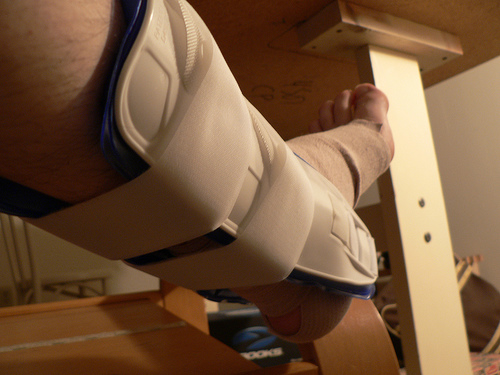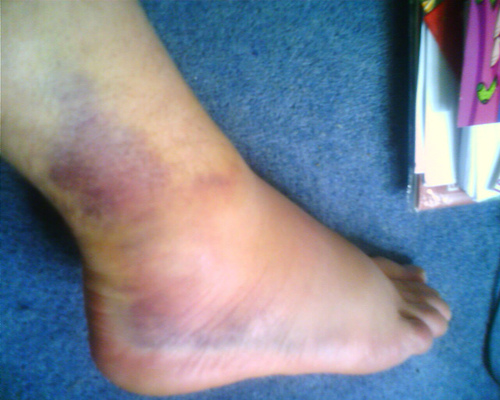Toby Cryne examines common ankle injuries and how you can prevent or treat ankle sprains and strains in the second part of our Injuries Examined feature.ʼ/em>
The ankle faces a huge task during everyday use. As the connecting joint between the leg and the foot, the area is prone to injury either through common wear-and-tear type stress or due to the effects of poor alignment.ˈousing not one, not two but three joints, the area has a role in just about every movement that the body makes when in an upright position including, stabilisation of the body, walking, standing and delivering a finesse pass through to the forwards.
But what happens when the ankle becomes sprained or strained and how can you correctly rehabilitate the area with a minimal amount of main and time wasting?ˆirstly, letֳ take a look at the physical characteristics and biomechanics of the areaɮ.
The Ankle Joint
As previously mentioned, the ankle joint houses three joints, the talocrural joint, the subtalar joint, and the Inferior tibiofibular joint which are constructed though the joining of the tibia, fibula and talus bones.[1]
- Talocrural Joint: A hinge joint that allows for both dorsiflexion and plantarflexion (movement of the foot up and down.[2]
- Inferior tibiofibular Joint: Connects the lower part of the tibia and fibula.
- Subtalar Joint: Responsible for inversion and eversion of the foot (outwards and inward movements) and shock absorbency.[3]
Connecting the bones and joints are a series of ligaments including the; deltoid ligament, lateral ligament and the tibio-fibula ligaments which contain a number of strands and fibres made up of collagen.[4] Ligaments are exceptionally strong by their nature and have many responsibilities such as; providing stabilisation to the joint, absorbing shock through impact and assisting in the alignment of connecting bones. Simply put, a ligament attaches one bone to another whereas a tendon attaches a bone to a muscle.

How do ankle injuries occur?
Ankle injuries are exceptionally common in all walks of sporting life Рtrust me; Iֶe had enough of them. But what are the common injuries associated to the ankle and how can we recover from them effectively and efficiently?
First, let us establish the difference between a strain and a sprain.
Sprain: As previously alluded to, a ligament attaches a bone to another bone. A sprain therefore is an injury that stretches and/or tears these fibres due to impact, overstretching and poor alignment.[5] Sprains exist on a spectrum of injuries which include partial tears to complete ruptures and are generally caused by impact or overstretching due to an impact such as when landing from a jump.
Symptoms of ankle sprain include:
- Localised pain
- Swelling
- Bruising
- Restricted movement
- Inability to bear weight
- Popping or tearing sound when injured[6]

Strain: In contrast, astrain is an injury that occurs in the tendons which connect muscle to bone and generally occur due to chronic overuse and high intensity training without adequate rest[7] though the can occur acutely through a sudden muscle contraction.
Symptoms of acute ankle strain include:
- Muscle spasm
- Loss of strength
- Limited range of motion
Symptoms of chronic ankle strain include:
- Inflammation
- Weakness at localised area
- Gradual onset pain[8]
The Ankle Sprain
Approximately 90% of ankle sprains occur in the tibio-fibular ligaments and occur when the foot rolls inwards. This inversion injury is common in sports such as football, basketball and even running when rapid changes in direction and poor foot placement cause the participant to roll the foot under the leg. The acute injury can be exceptionally painful due to the nature of the action, in which the ligament strands will be forced to handle the entire bodyweight which can cause slight tears, complete tears and complete ruptures. In some cases the force may cause a piece of the attaching bone to become dispatched from the joint which can cause further pain and injury during the rehabilitation process. A sprained ankle falls into one of three categories; Grade I (slight tear), Grade II (partial tear) and Grade III (rupture).
Less frequently, the ligaments of the interior side of the joint may become sprained or ruptured, though this is often due to a break in the joint or heavy impact.
The Ankle Strain
Chronic overuse tendon sprains in the ankle, specifically the peroneal tendons, are common in repetitive athletics such as running and cycling where the biomechanics of the action are often unchanged for hours at a time. This chronic injury is often known as tendinitis and occurs when micro-tears form due to repeated over-stretch. Not allowing these micro-tears to properly heal can cause them to rupture or slip out of place due to weaknesses. However, tendons can also become injured due to acute injuries, most often from a large impact or breakage in the joint.[9]
Treating an ankle injury
Having determined, through medical expertise, the extent of your injury and which category it falls under, the proper rehabilitation is paramount to continued ankle strength and avoiding similar injuries in the future.
Warning: If a slight acute injury is left untreated it can, over time, become a chronic condition that results in far worse repercussions.
Both strains and sprains require very similar treatment methods in the acute phase the strains may require further strengthening with specified exercises post-recovery. For a Grade I or II injury, the following treatment is recommended by medical professionals and physiotherapists:
- Rest: Limit the movement of the area and reduce weight bearing to allow the micro-tears to reattach. Ankle braces such as the Aircast A60, as used by Andy Murray will help to keep the joint stable both during and following rehabilitation. If all else fails, use crutches.
- Ice: Ice reduces inflammation and helps to keep swelling to a minimum. Ice bags such as The PhysioRoom.com Instant Ice Packˡllow you to treat the area without destroying bags of˦rozen peas. Ice for 10-20 minutes at a time to avoid burning the skin and frostbite.
- Compression:ʼ/strong>Compressing the area with a tight bandage or ankle brace such as the one listed above will promote blood flow and assist in the reduction of swelling. Consider wearing a brace at all times if you suffer from these injuries often.
- Elevation: Elevating the leg above the heart also promotes blood flow to the foot which will assist in a speedy recovery.

For Grade III sprains, a doctor should be seen and physiotherapy should be sought as the risk of permanent damage is relatively high. If your doctor permits you to do so, a walking boot such as theʼa title=”PhysioRoom.com Air Walker” href=”https://www.physioroom.com/walking-braces-splints” target=”_blank”>PhysioRoom.com Air Walkerˣan be used to minimise the movement of the joint and absorb the shock of walking.
Exercises
Once you have rehabilitated the acute injury, itֳ time to do some strengthening exercises to stabilise and restructure the joint. Check out our guide to ankle strengthening here.ˈave you had an injury to the ankle? Did our guide help? Let us know by using the social media links below!
[1] http://en.wikipedia.org/wiki/Ankle
[2] http://www.sportsinjuryclinic.net/anatomy/ankle-anatomy
[3] http://www.scoi.com/specialties/anatomy-ankle
[4] http://www.cambridgefootandankle.com/ankle-ligaments.shtml
[5] http://orthoinfo.aaos.org/topic.cfm?topic=A00111
[6] http://www.bupa.co.uk/individuals/health-information/directory/s/sprained-ankle
[7] http://orthoinfo.aaos.org/topic.cfm?topic=A00111
[8] http://www.hughston.com/hha/a.strain-sprain.htm
[9] http://www.webmd.com/fitness-exercise/ankle-injuries-causes-and-treatments


